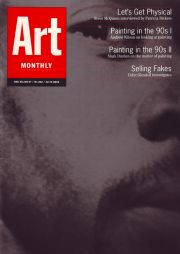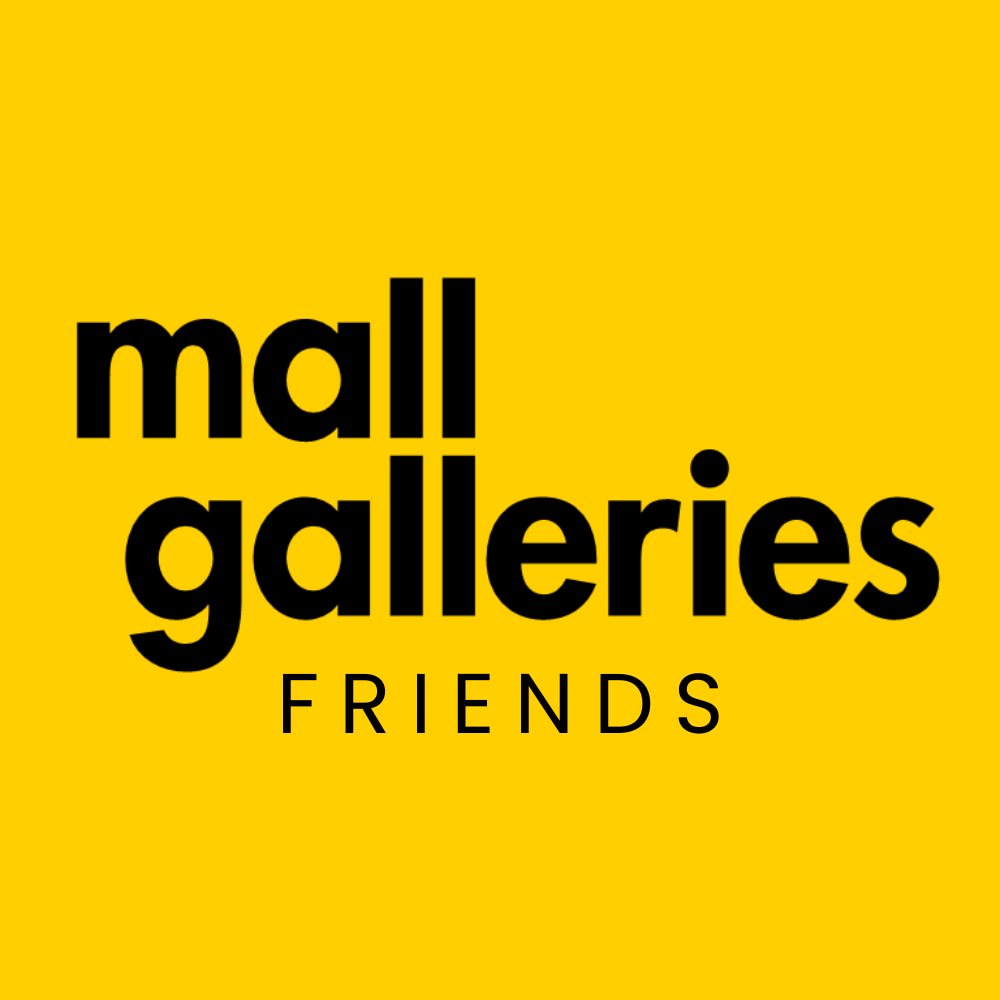Feature
The Vision Thing
Andrew Wilson finds that ‘About Vision’ is more about looking
‘About Vision’ is not a quiet experience, quite the reverse. In what is an overcrowded hang, a cacophony of sight has been created in which diversity and difference are celebrated.
The illusion of the trajectory of Modernist certitude has been overwritten by the exhibition’s achievement in declaring, quite categorically, that painting today is most often created not from an understanding of certainty but is instead the result of the lack of certainty. Nevertheless, this is not to suggest that the paintings are themselves the result of a questioning of this state in some vaguely existential and troubled way. There is little observable tussle with medium, subject or meaning either; instead there is an assured, resolved, cast to the paintings’ forms. Uncertainty is, instead, accepted as a given within the realm of aesthetic and material transformation as much as in daily life. And it is from daily life, as lived both inside and outside the studio, that the material of these paintings derive their meaning.
‘About Vision’, however, is not necessarily an attack on Modernism. David Elliott, in the exhibition’s catalogue, discussed at length the development of painting through the 1980s and suggested that what distinguished painting in the 1990s was that any attention to reference or sources was indexical ‘not within the context of the historicist morass of eighties Postmodernism but in a contemporary playground in which the languages ... have been scrambled together’. Such an assessment as this is actually closer to an understanding of the terms by which Baudelaire characterised the Modern condition in his The Painter of Modern Life, first published in 1863, where he wrote that ‘Modernity is the transient, the fleeting, the contingent; it is one half of art, the other being the eternal and the immutable’. The Modern condition, and here Baudelaire is describing specific content rather more than he is an abstract philosophical imperative, is formed out of a sense of tension in which aesthetic identity can never adequately be defined by just how something looks. Instead Baudelaire points to a condition that is played out in terms of a struggle between the facts and experience of daily life which are fragmentary, transitory, arbitrary, uncertain, ambiguous and ephemeral, and the attempts to fix those facts, by recourse to what Baudelaire termed the ‘eternal and the immutable’.
Above everything else, with this exhibition David Elliott is celebrating a situation where there is an absence of a dominant style and a dominating voice. The monolith of an essentialist or historicist Modernism (or Postmodernism) has been exchanged for a polyphony in which painting has found its capacity for reinvention. Nevertheless, the exhibition’s installation goes against this thesis to some degree by opposing paintings that might seem more rigorously non-figurative, process-based, or that dice with the fiction of a Modernist endpoint, with pictures that are figurative or constructed through a diminished narrative. In this sense, downstairs we have a battle of two walls – the left being more or less abstract (Mark Francis, Richard Wright, Callum Innes, Ian Davenport, Jane Harris) and the right wall being more or less figurative (Richard Patterson, David Austen, Chris Ofili, Alain Miller).
Upstairs the pattern continues but in rather more weighted terms. In the back gallery we find the monochromes of Clem Crosby and Jason Martin, juxtaposed with the paintings of Davenport, Innes and Simon Callery. The smaller gallery continues the battle, opposing Glenn Brown’s paintings with those of Jane Harris, while the main gallery is largely hung with the more figurative work of Ofili, Peter Doig, Marcus Harvey, Richard Patterson, Lisa Milroy and Fiona Rae. This is a pity because the exhibition is not really about how something looks but much more about locating an open field for painting in which conceptual strategies both confirm or confound ideas of visuality; that what is seen is not necessarily what is there.
In this respect the room that pits Harris’s paintings against Brown’s, or the juxtaposition of paintings by Milroy, Rae and Doig, emphasises the degree to which painting’s capacity for reinvention takes place between what the mind knows and the eye sees, as an issue of representation. Paintings by these five artists (and by the other 14 in the exhibition) are made in the recognition that any painted mark is at once the thing itself (paint that has been ‘left behind’ in a particular way) and at the same time a representational mark of something else and a mark of representation. This juggling between being something and showing something else ‑ but in the same place and by virtue of the same mark ‑ suggests an illusory divide between presentation of that which is known by being ‘unchanged’ and representation of that which comes to be known through creative transformation. All of which exchanges an idea of depiction for something more akin to Roland Barthes’s ‘third meaning’, which is both fixed and fluid, and where painting must constantly be the subject of a reappraisal within painting itself.
Harris’s brush marks signify both a tradition of painting and the image that those marks form; a coding that is short-circuited by Brown’s strategy of repainting paintings derived from their photo-mechanical reproductions. The brush mark becomes less gestural, less significant as far as authorship is concerned and more psychotic. The marks in Brown’s painting, I lost my heart to a starship trooper, 1996, after a School of Rembrandt portrait, are trapped neither within the painting as image nor in the process that originally formed its source but in another place. Similarly, Rae’s new paintings such as Untitled (emergency room), 1996, celebrate a lack of fixity within the image by her recourse to the deployment of a language of interference whereby the traditional figure-ground relationship is upset. Meaning is then made not by the construction of spatial illusion but by the presentation of a jumble of signs that are remade, in sight, as meaning and that gives a structure to an idea of chaos. It is as if the content has to move out of sight to be again remade as a painting that might reveal its meaning to the viewer, rather than just depict it. Within a more obviously figurative painting such as Doig’s Night Fishing, 1993, or Milroy’s three Kimono paintings of 1996, this strategy ‑ where meaning can be both confirmed and confounded by the image ‑ is perhaps clearer. Doig’s description of his painting ‑ as ‘an attempt to paint a disappearance. The figures and boat are on the verge of a dissolve into landscape-picture-space’ ‑ reinforces this sense of ambiguity and uncertainty in which the viewer has constantly to ask to what reality these paintings refer.
There is indeed, as Alain Miller has written in the catalogue, ‘something odd about painting’. His visual, archimboldesque conceits, such as Autonomous Painting of 1996, propose an ideal of circularity, between the painted image and its reception, that continually breaks down when one questions what it actually is that we are looking at. Similarly one has to ask to what extent, with Milroy’s Kimono paintings, the paintings are about the image of women wearing Japanese bridal kimonos or have more to do with a questioning of conventions of language (whether pictorial or other) that a representation of such an image, as a painting, induces in the viewer.
In all this, Elliott is right to suggest that recent painting is not determined by a continuation of the division between the non-figurative, the abstract and the representationally figurative, and that ‘painters are now not so much concerned with the pictorial’. But then to suggest that they are, instead, now ‘concerned with the sculptural ‑ or, more accurately, the object-based ‑ nature of the work’ seems rather to miss the point. There is little evidence, in this exhibition at least, that this is necessarily the case. Instead ‘About Vision’ suggests that painting is now being made, and perhaps reinvented, through an awareness not just of what painting is, materially, but also of what it shows (or doesn’t) in terms of image so that, between the two, between the ‘eternal and the immutable’, an attempt can be made to find a point of stability for the making of meaning, which is about looking.
About Vision, New British Painting in the 1990s is at the Museum of Modern Art, Oxford until February 23 1997.
Andrew Wilson is an art critic.
First published in Art Monthly 202: Dec-Jan 96-97.






